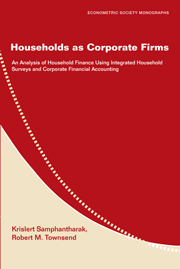 Households as Corporate Firms
Households as Corporate Firms Book contents
- Frontmatter
- Contents
- Preface
- PART I HOUSEHOLDS AS CORPORATE FIRMS
- PART II HOUSEHOLD FINANCIAL ACCOUNTING
- PART III HOUSEHOLD FINANCE
- 5 Financial Analysis
- 6 An Application: Liquidity Constraints, Kinship Networks, and the Financing of Household Investment
- 7 Discussion: Measurement and Modeling
- Appendix: Examples of Financial Statements
- References
- Index
- Titles in the series
5 - Financial Analysis
Published online by Cambridge University Press: 05 January 2013
- Frontmatter
- Contents
- Preface
- PART I HOUSEHOLDS AS CORPORATE FIRMS
- PART II HOUSEHOLD FINANCIAL ACCOUNTING
- PART III HOUSEHOLD FINANCE
- 5 Financial Analysis
- 6 An Application: Liquidity Constraints, Kinship Networks, and the Financing of Household Investment
- 7 Discussion: Measurement and Modeling
- Appendix: Examples of Financial Statements
- References
- Index
- Titles in the series
Summary
Part III of the monograph illustrates how we use the accounts in an analysis of household finance. We demonstrate two different, but complementary, approaches. In chapter 5, we conduct a simple financial analysis of two illustrative case study households selected from the Townsend Thai Monthly Survey. In chapter 6, we apply regression analysis to the entire sampled households in the survey and study liquidity constraints and the financing of household investment.
The case study approach is commonly used by corporate financial analysts and creditors, as one wants to know how well, or how poorly, a given firm or household is doing. The findings from the case study method are likely to be specific and may not be general so in this chapter we supplement each finding from these two households with the quartiles from their corresponding provinces. These quartiles not only allow us to make comparative statements of the case study households relative to others in the same region, but also give us important summaries of key statistics in the Townsend Thai data.
The chapter proceeds as follows. Section 5.1 describes the two households that we picked as our case studies. It also discusses the financial accounts we constructed for these two households. With these accounts in hand, we move on to financial analysis of household behavior. Section 5.2 applies the standard financial ratios and rates of return to analyze the productivity of the households.
- Type
- Chapter
- Information
- Households as Corporate FirmsAn Analysis of Household Finance Using Integrated Household Surveys and Corporate Financial Accounting, pp. 79 - 116Publisher: Cambridge University PressPrint publication year: 2009


